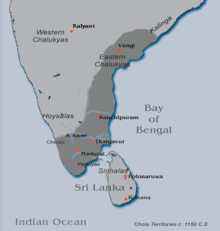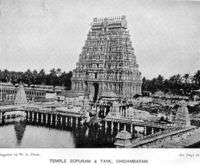Kulothunga Chola II
| Kulothunga Chola II இரண்டாம் குலோத்துங்க சோழன் | |
|---|---|
| Rajakesari | |
 Chola territories c. 1150 CE | |
| Reign | c. 1133 – c. 1150 CE |
| Predecessor | Vikrama Chola |
| Successor | Rajaraja Chola II |
| Died | 1150 CE |
| Queen |
Tyagavalli Mukkokilan |
| Issue | Rajaraja Chola II |
| Father | Vikrama Chola |
| List of Chola kings and emperors | ||||||||||||||||||||||||||||
|---|---|---|---|---|---|---|---|---|---|---|---|---|---|---|---|---|---|---|---|---|---|---|---|---|---|---|---|---|
| Early Cholas | ||||||||||||||||||||||||||||
| Interregnum (c. 200 – c. 848) | ||||||||||||||||||||||||||||
| Medieval Cholas | ||||||||||||||||||||||||||||
|
||||||||||||||||||||||||||||
| Later Cholas | ||||||||||||||||||||||||||||
|
||||||||||||||||||||||||||||
| Related dynasties | ||||||||||||||||||||||||||||
|
||||||||||||||||||||||||||||
| Chola society | ||||||||||||||||||||||||||||
Kulothunga Chola II was a 12th-century king of the Chola Dynasty of the Tamil people of South India. He succeeded his father Vikrama Chola to the throne in 1135 CE. Vikrama Chola made Kulothunga his heir apparent and coregent in 1133 CE, so the inscriptions of Kulothunga II count his reign from 1133 CE.[1] Kulothunga II's reign was a period of general peace and good governance.[2]
Extent of Empire
The extent of empire as inherited from his predecessor Vikrama Chola was well maintained. The Western Chalukya kingdom was overthrown by the Yadava chiefs of Dwarasamudra and Devagiri during this period. Kulottunga II took advantage of the internal skirmishes and rebellions in the Kannada and Chalukya country to establish his hold over Vengi and Eastern Chalukya territories. Gonka II of the Velanadu Choda family who ruled over northern part of Vengi acknowledged his supremacy. Similarly the Cuddapah-Nellore chief, Madurantaka Pottapi Choda, son of Betta I and Buddhavarman III of the Kondavidu branch and his son Mandaya II also acknowledged the king's authority in the Andhra country.[3]
Patron of Chidambaram
Chidambaram is one of those five places where Chola princes were invested with the crown. Kulothunga was a great devotee of the Chidambaram Temple to Lord Shiva in that city, and he celebrated his coronation there. An inscription of the king from Tirumanikuli hails this event and states that king celebrated his coronation so as to add lustre to the city of Tillai(Chidambaram).[4]
He also financed an elaborate renovation of the temple as described in the poem Kulothunga Cholan Ula. It is possible that this renovation work was a continuation of work started by Vikrama Chola. Kulottunga II is credited with gilding the Perambalam of the Nataraja Temple, Chidambaram with gold. He is also said to have constructed its gopurams and the Thousand Pillared Hall.[5][6]

Literature
Kulottunga II's reign was marked by literary activity as evidenced by the works of Sekkizhar and Ottakoothar.[7] Sekkizhar composed the Periyapuranam, a religious treatise on Shaivism during his reign.[8] The Kulottunga Cholan Ula and the Kulottunga Cholan Pillai Tamil, a work dealing with the king's childhood were authored by Ottakoothar in honor of the king.[9]
Personal life and family
The Kulottunga Cholan Ula hails Kulottunga II as the son of a princess belonging to the lunar race from Tuvarai. Scholars identify his mother as a Hoysala princess based upon this detail. U.V Swaminatha Iyer identifies her as the daughter of a Velir chieftain from Dwarasamudra.[10]
Kulothunga II preferred to live in Chidambaram rather than the royal capital at Gangaikonda Cholapuram. Of the various titles he had, Anapaya was perhaps his favourite. It is found in his inscriptions as well in the poetic tribute Kulothunga Cholan Ula.[11] He was also called Tirunirruchola.[12]
Kulothunga II was succeeded by Rajaraja Chola II in 1150 CE.
Persecution of Vaishnava
Kulothunga II seems to have been a strong opponent of vaishnavas. The work Parpannamritam (17th century) refers to a Chola king called Krimikanta who is said to have removed the Govindaraja idol from the Chidambaram Nataraja temple.[13] The Kulothunga Cholan Ula states that the during the reign of Kulottunga II, God Vishnu was sent back to his original abode, that is the sea.[14]
Inscriptions
The Tyagarajaswami temple in Tiruvarur contains an inscription of the king in which he styles himself as King Anapaya and a bee at the lotus feet of Natesa at Chidambaram.[11]
In Popular culture
In the film Dasavathaaram, Napoleon (actor) portrays the role of Kulothunga Chola II.
Notes
- ↑ K.V. Raman. Sri Varadarajaswami Temple, Kanchi: A Study of Its History, Art and Architecture. Abhinav Publications, 2003 - 206 pages. p. 15.
- ↑ Yashoda Devi. The History of Andhra Country, 1000 A.D.-1500 A.D.: Without special title. Gyan Publishing House, 1993 - Andhra Pradesh (India) - 528 pages. p. 18.
- ↑ Government Of Madras Staff, Government of Madras. Gazetteer of the Nellore District: Brought Upto 1938. Asian Educational Services, 1942 - Nellore (India : District) - 378 pages. p. 43.
- ↑ S. R. Balasubrahmanyam; B. Natarajan; Balasubrahmanyan Ramachandran. Later Chola Temples: Kulottunga I to Rajendra III (A.D. 1070-1280), Parts 1070-1280. Mudgala Trust, 1979 - Architecture - 470 pages. p. 102.
- ↑ Archaeological Survey of India, India. Dept. of Archaeology. Epigraphia Indica, Volume 27,Volumes 13-14 of [Reports]: New imperial series, India Archaeological Survey. Manager of Publications, 1985. p. 96.
- ↑ Madras (India : State). Madras District Gazetteers, Volume 1. Superintendent, Government Press, 1962. p. 55.
- ↑ Sailendra Nath Sen. Ancient Indian History and Civilization. New Age International, 1999 - India - 668 pages. p. 486.
- ↑ Karen Pechilis Prentiss. The Embodiment of Bhakti. Oxford University Press, 06-Jan-2000 - Religion - 288 pages. p. 117.
- ↑ Prema Kasturi; Chithra Madhavan. South India heritage: an introduction. East West Books (Madras), 2007 - History - 616 pages. p. 294.
- ↑ Govindan Thirumavalavan. Political, social, and cultural history of the Chōl̲ās as gleaned from Ulā literature. Ezhilagam Publishers, 1991 - History - 244 pages. pp. 101–102.
- 1 2 P. V. Jagadisa Ayyar. South Indian Shrines: Illustrated. Asian Educational Services, 1982 - Hindu shrines - 638 pages. p. 216.
- ↑ Vidya Dehejia. Slaves of the Lord: The Path of the Tamil Saints. Munshiram Manoharlal, 1988 - Art - 206 pages. p. 19.
- ↑ B. Natarajan; Balasubrahmanyan Ramachandran. Tillai and Nataraja. Mudgala Trust, 1994 - Chidambaram (India) - 632 pages. p. 108.
- ↑ Three great Acharyas: Sankara, Ramanuja, and Madhwa: critical sketches of their life and times: an exposition of their philosophical systems. G. A. Natesan, 1947. p. 126.
References
- Nilakanta Sastri, K.A. (1935). The CōĻas, University of Madras, Madras (Reprinted 1984).
- Nilakanta Sastri, K.A. (1955). A History of South India, OUP, New Delhi (Reprinted 2002).
| Preceded by Vikrama Chola |
Chola 1133–1150 CE |
Succeeded by Rajaraja Chola II |